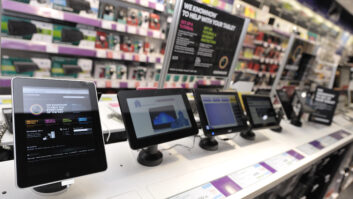NEW YORK — Addressing the millions of tons of e-waste expected as the DTV transition rolls along, and the many confusing and disparate e-waste recycling policies among the 50 states, six major electronics manufactures have rolled out national collection efforts to simplify the process of responsible set disposal.
At issue immediately is creating a safe and convenient way for consumers to dispose of their unwanted electronics devices, particularly now that the nation is nearing the completion of its transition from an analog to all digital TV transmission system.
Like computers, televisions based on old cathode ray tube technology, and even some newer flat-screen sets, contain environmentally toxic elements including lead and mercury.
Among other things, if these substances accumulate in landfills, they can leach into the ground water and possibly run off into nearby streams, ponds and oceans.
Six states have passed laws making it illegal to simply throw a TV away in a landfill, and another five are expected to do so in 2010. Eighteen states, as well as New York City, have ordered electronic recycling programs.
Barbara Kyle, national coordinator of the Electronics Take Back Coalition, an advocacy group for environmentally safe electronics recovery policies, said
Most companies receiving lower grades did so for not having fully established networks of collection sites in place nationwide, according to a coalition statement.
Sony was among the first to get the recycling ball rolling in September 2007, when it launched its “Take Back” network of collection sites around the country. Those locations now have grown to more than 274 permanent depots across the country.
Sony started the program as one of the “first nationwide electronics-recycling programs” of its kind, targeting the collection of both waste TVs and other electronics devices, in association with WM Recycle America, a wholly owned subsidiary of Waste Management.
Sony has expanded the program since the launch to include the collection services of Eco International, which among other sites, has added certain UPS stations in Texas, Rhode Island and West Virgina as e-waste collection centers.
The program allows consumers to bring their end-of-life Sony TVs and other Sony products to one of the drop-off sites free of charge. Varying fees are assessed for products of other brands brought to the drop-off locations.
A Sony spokeperson said the Take Back program has collected more than 14 million waste electronics products since launch, and that Sony has appointed a team to audit the processing centers, recycling vendors and the collection points.
Similarly, last fall Panasonic, Sharp and Toshiba, launched a comprehensive electronics-recycling program in select states, concentrated mostly on the Eastern seaboard, before ramping up to some 280 collection sites covering a full national footprint in early 2009. It is scheduled to reach more than 400 sites by the end of 2009, with a total goal of reaching 800 collection sites across the country by 2011, said Frank Marella, Sharp environmental affairs manager.
The effort is being coordinated by MRM, a jointly operated venture between Sharp, Panasonic and Toshiba.
Like Sony’s efforts, the MRM sites are designed to collect TVs and other electronics products as well. In most cases, end-of-life products are taken free of charge if they carry a Panasonic, Sharp or Toshiba brand. Depending on the site, they may or may not charge for products from other brands, Marella said.
However, one of the program’s goals is to include other companies and manufacturers, offering them a turnkey collection solution, which they can use and advertise as their own, after signing onboard.
“If we are really going to make electronics recycling cost-effective and environmentally sustainable, we need economies of scale both on collection and on recycling,” said David Thompson, Panasonic corporate environmental affairs director. “We based our program on the idea of working collaboratively with other companies to implement it.”
For example, MRM teamed up on a pilot program basis with Goodwill in Austin, Texas, which provided 36 collection locations in the middle Texas area. The group is looking for similar opportunities in other areas.
Goodwill, which had worked in the past with Dell on taking back end-of-life computer products, was in need of a TV solution and approached MRM about joining the program.
The program is ideal for CE retailers as well, executives said.
Sharp’s Marella said, “We’ve been in discussions with some retailers, and there are some participating with our programs in Oregon as customers now, but we have had discussions about bringing them on as part of the network.”
Matt Gobble, Toshiba environmental affairs senior manager, said the member companies maintain stringent oversight to ensure that products are taken back in accordance with the laws of each state, and efforts are carefully audited.
“We want to be able to ensure the products are recycled in both a cost-effective and environmentally safe manner,” Gobble said.
Samsung established Samsung Recycling Direct (SRD) on Oct. 1, 2008, as one of four electronics recycling programs, which together cover most the company’s core product areas, said Kris Narayanan, Samsung’s integrated marketing director.
The SRD portion covers TVs and other CE products and uses four electronics-recycling firms directly contracted by Samsung–Sims, CRT, Eco International and JFRC.
To date, the partners have established 206 drop-off centers throughout the 50 states, with plans to continually add new collection locations.
Each site accepts all Samsung-branded electronics goods — excluding home appliances — for no fee, as well as similar products from other brands at a fee determined by the local recycling center.
Samsung has also collaborated on recycling ventures with some of its retail partners. Wal-Mart and Samsung teamed to allow consumers to take back not only Samsung-branded CE products, but Wal-Mart-branded products — iLo and Durabrand — for no fee to all Wal-Mart customers.
In addition, Samsung established a permanent drop-off location at Abt Electronics in Chicago.
Samsung promotes the service with special events designed to create some buzz in the local markets by offering temporary drop off points in or near big venues, such as NASCAR races, NBA games and NFL rallies.
Narayanan said that by working directly with the recycler, instead of a collection firm, Samsung has more oversight and control over the responsible breakdown, recycling and disposal of waste materials.
Like Sony, LG Electronics has partnered with Waste Management on its national LG Electronics Recycling Program.
The program will accept unwanted LG-branded electronics products for free. Waste Management currently has 160 designated drop-off sites across the United States, with at least one drop-off site in each of the 50 states, and plans to expand that effort in 2009 and beyond.
Sony, Samsung, LG, Panasonic, Sharp and Toshiba have made “a start” in addressing the problem of the growing e-waste stream, but “we are interested in seeing a significantly more convenient network of collection opportunities. Otherwise consumers are not going to use them.”
Sony, Samsung, LG, Panasonic, Sharp and Toshiba have made “a start” in addressing the problem of the growing e-waste stream, but “we are interested in seeing a significantly more convenient network of collection opportunities. Otherwise consumers are not going to use them.”
The coalition recently issued a report card for electronics manufacturers’ recycling efforts. None received an A and only Sony received a B minus. LG, Samsung and Wal-Mart followed with C’s.













